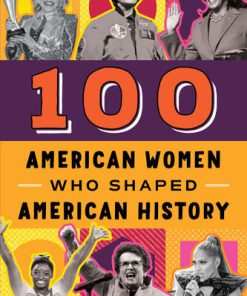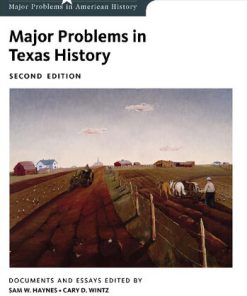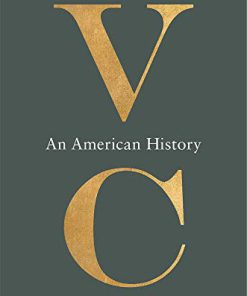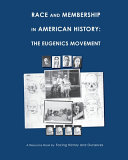Major Problems in Asian American History 2nd Edition by Lon Kurashige, Alice Yang ISBN 9781285433431 1285433432
$50.00 Original price was: $50.00.$25.00Current price is: $25.00.
Major Problems in Asian American History 2nd Edition by Lon Kurashige, Alice Yang – Ebook PDF Instant Download/Delivery: 9781285433431 ,1285433432
Full download Major Problems in Asian American History 2nd Edition after payment
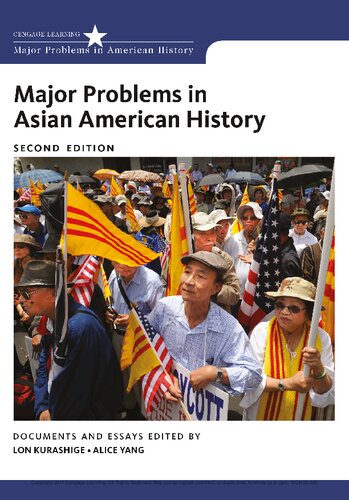
Product details:
ISBN 10: 1285433432
ISBN 13: 9781285433431
Author: Lon Kurashige, Alice Yang
Designed to be the primary anthology or textbook for courses in Asian American history, this collection covers the subject’s entire chronological span. The volume presents a carefully selected group of readings that requires students to evaluate primary sources, test the interpretations of distinguished historians, and draw their own conclusions.
Important Notice: Media content referenced within the product description or the product text may not be available in the ebook version.
Major Problems in Asian American History 2nd Edition Table of contents:
Chapter 1: Asian American History By The Generation
Essays
Helen Zia – From Nothing, A Consciousness
Vijay Prashad – The Forethought: Raw Skin
Wesley Yang – Paper Tigers: What Happens To All The Asian-American Overachievers When The Test-Takin
Paul Spickard – Whither The Asian American Coalition?
Erika Lee And Naoko Shibusawa – What Is Transnational Asian American History?
Further Reading
Chapter 2: Transpacific Crossings, 1688–1883
Documents
1. Spanish Visitor Describes The Philippine Market, 1663
2. Manager Of Cargo Reports On First U.s. Ship To Trade With China, 1785
3. U.S. Bases Citizenship On Race, 1790
4. Hawaiians Petition The Privy Council To Halt Foreign Influence In The Islands, And Council Replie
5. Foreign Experts Stress Optimism For Agriculture In Hawai’i, 1850
6. Senator Wants Millions Of Chinese Laborers In The United States, 1852
7. Song Captures Reasons For Chinese Sojourn To United States, 1852
8. Two Songs Reveal Concerns Of Wives Left In China, n.d. [late 1800s]
9. Journalist Reveals Filipino Roots Of American Community, 1883
Essays
Ronald Takaki – Hawai’i And The Global Labor Market
Elizabeth Sinn – Chinese Emigration To California
Further Reading
Chapter 3: Debating Chinese Immigration, 1860–1899
Documents
1. Newspaper Distinguishes Between Good Coolies, Bad Coolies, And Free Asian Immigrants, 1860
2. Congress Excludes Un-free Asians, Prostitutes, And Felons, 1875
3. Chinese Immigrant Leaders Discourage Further Immigration From China, 1876
4. White Merchant Testifies Against Chinese Immigration, 1879
5. Graphic Comic Depicts Chinese Labor Threat, 1881
6. U.S. Senator Declares Chinese Exclusion Un-American, 1882
7. Chinese Laborers Report On Race Riot At Rock Springs, Wyoming Territory, 1885
8. Chinese Immigrant Objects To The Hypocrisy Of The Statue Of Liberty, 1885
9. Journalist Exposes Activities Of Chinese Brothel Owner, 1899
Essays
Beth Lew-Williams – From Chinese Restriction To Exclusion
Emma Junhua Teng – Debating Mixed Marriage In The United States And China
Further Reading
Chapter 4: Pacific Empires And New Migrations, 1894–1919
Documents
1. Japanese Newspaper Jiji Shimpo Views Emigration As Sign Of Japan’s Military Power, 1896
2. Japanese Immigrant Comic Reveals Reasons For Emigration, 1904 (1929)
3. Senator Albert Beveridge Champions Philippine Colonization, 1900
4. American GIs Sing About Using Water Cure Torture, 1902
5. U.S. Civilian Officer Condemns Racial Prejudice In Philippines, 1902
6. Indian Nationalist Articulates An Anti-Imperial Vision For Asian Youth, 1917
7. Chinese Leader Urges Asian Unity, 1917
8. Korean Congress Declares Independence From Japanese Rule, 1919
9. Korean Immigrant Hee Kyung Joins The Korean Independence Movement, 1919 (1989)
Essays
Eiichiro Azuma – Heterogeneous Origins Of Japanese America
Paul Kramer – Filipino Students And The Politics Of Racial Inclusion
Further Reading
Chapter 5: New “Oriental Problems,” 1900–1918
Documents
1. American Writer Decries The New Yellow Peril, 1904
2. President Roosevelt Warns Against Anti-Japanese Racism, 1906
3. Asiatic Exclusion League Argues Against Japanese And Korean Immigration, 1908
4. Japanese Immigrants Oppose California Alien Land Law, 1913
5. Californian Insists The Japanese Are A Race Problem, 1913
6. Indian Immigrant Claims Group Is Assimilable, 1914
7. U.S. Commissioner General Of Immigration Says Indian Immigrants Are Unassimilable, 1914
8. Poems Describe Chinese Detention By U.S. Immigration Authorities, n.d. (1910–1930)
9. Newspaper Issues Alert About Gambling In Chinatown, 1918
Essays
Kornel Chang – Policing Borders In The Pacific Northwest
Nayan Shah – Regulating Intimacy And Immigration
Further Reading
Chapter 6: Politics Between The World Wars, 1918–1937
Documents
1. Laborers Report On Hawai’i Sugar Strike, 1920
2. American Official Extols Race Relations In Hawai’i, 1932
3. Americans Provide Diverse Perspectives On Anti-Japanese Racism, 1922
4. U.S. v. Bhagat Singh Thind, 1923
5. Californian Testifies For The Exclusion Of Filipino Immigrants, 1930
6. Leader Of Philippines House Of Representatives Reveals Trade-Off Between Exclusion And Independen
7. Filipino Immigrants Petition Congress For Repatriation, 1932
Essays
Rick Baldoz – Filipino Exclusion And Philippine Independence
Maile Arvin – Challenging The Construction Of Hawai’i As America’s Racial Laboratory
Further Reading
Chapter 7: Americanization And The Second Generation, 1924–1941
Documents
1. American-born Chinese Woman Longs For Unconventionality And Freedom, 1924
2. Author Pearl Buck Identifies As Immigrant From China, 1937
3. American-born Filipina Connie Tirona Recalls Growing Up In Immigrant Community, 1930s And 1940s (
4. American-born Korean Dora Yum Kim Recalls Growing Up In Chinatown, 1920s–1940s (1999)
5. Activist Supports Naturalization Of Asian Veterans Of World War I, 1925
6. Japanese Immigrant Veteran Argues For U.S. Citizenship, 1935
7. American-born Japanese Bemoans Limited Job Opportunities, 1937
Essays
Karen J. Leong – The Racialized Image Of Anna May Wong
Lon Kurashige – The Problem Of Japanese American Biculturalism
Further Reading
Chapter 8: The Mass Removal And Detention Of Japanese Americans, 1942–1948
Documents
1. Chief Of Naval Operations Kenneth Ringle Reports On Japanese American Loyalty On The West Coast,
2. Lieutenant General John L. Dewitt Recommends The Removal Of Japanese Americans From The West Coas
3. Japanese American Mike Masaoka Vows To Cooperate With Government Removal Plans, 1942
4. An Anonymous Poet Denounces The Incarceration Of Japanese Americans, 1943
5. Yamato Ichihashi Writes A Letter Describing The Segregation Of Supposedly “Disloyal” Japanese Ame
6. Nisei Soldiers Help Rescue A Lost Battalion, 1944
7. The Fair Play Committee Calls On Nisei, Second-Generation Japanese Americans, To Resist The Draft
8. Justice Frank Murphy Criticizes The Supreme Court’s “legalization Of Racism,” 1944
9. Esther (Takei) Nishio Describes Returning To The West Coast, 1944
Essays
Alice Yang – The Internment Of Japanese Americans
Michael Jin – Japanese American Citizenship, Loyalty, And The “kibei Problem” During World War II
Further Reading
Chapter 9: War And Asia-Pacific Allies, 1941–1950
Documents
1. The U.S. War And Navy Departments Tell U.S. Soldiers “How To Spot A Jap,” 1942
2. Sociology Graduate Student Rose Hum Lee Describes How World War II Changed The Lives Of Chinese A
3. Madame Chiang Kai-shek Speaks To Congress On The Need To Provide Military And Economic Aid To Chi
4. Franklin Delano Roosevelt Calls On Congress To Repeal Chinese Exclusion, 1943
5. Indians In America Call For Repeal Of U.S. Exclusion Laws, 1945
6. Filipino Regiment Member Manuel Buaken Fights For Freedom, 1943
7. Rosa Roberto Carter Recalls Starvation And Loyalty Interrogation In Guam, 1941–5 (2003)
8. Ben Blaz Describes The Lessons Of The Liberation Of Guam, 1945 (1994)
Essays
Xiaojian Zhao – World War II And Chinese American Women Defense Workers
Jane Hong – The Movement To Repeal Asian Exclusion
Further Reading
Chapter 10: Asian Americans And The Cold War, 1945–1965
Documents
1. Honolulu Record Editor And Labor Leader Koji Ariyoshi Describes The Arrest Of Seven Suspected Com
2. Congress Expands Immigration And Naturalization Rights For Asian Immigrants, 1952
3. Life Magazine Condemns Southwood’s Denial Of Housing To Sing Sheng, 1952
4. Setsuko Kamei Works At A U.S. Army Camp And Becomes A War Bride, 1952
5. A Hollywood Poster Sells Interracial Love And The Exoticism Of Japan In The Film Sayonara, 1957
6. Korean Adoptee Deann Borshay Liem Looks For Her Birth Family, 1966 (2010)
Essays
Cindy I-Fen Cheng – Chinese Americans And The Politics Of Cultural Citizenship In Early Cold War Ame
Arissa Oh – The Cold War Transformation Of The Korean Orphan
Further Reading
Chapter 11: The Rise Of Asian American Identity, 1965–2012
Documents
1. Malcolm Collier And Dan Gonzales Recount The Origins Of The San Francisco State Strike, 1968 (200
2. Activist Amy Uyematsu Proclaims The Emergence Of “Yellow Power,” 1969
3. Asian Americans In Los Angeles Protest Against The Vietnam War, Late 1960s
4. Al Robles Celebrates The Manongs And The International Hotel, 1970s (2002)
5. Althea Yip Remembers The Legacy Of The Death Of Vincent Chin, 1997
6. Urvashi Vaid Criticizes Heterosexism And Patriarchy In Racial Justice Movements, 1999
7. Annalisa V. Enrile And Jollene Levid Describe Gabriela Network’s Transnational Sisterhood And O
8. Jeff Yang Discusses Multiracialism And Asian American Identity, 2011
9. C.N. Le Criticizes The Pew Report’s Depiction Of Asian Americans As Model Minorities, 2012
Essays
Judy Tzu-Chun Wu – Journeys For Peace And Liberation: Third World Internationalism And Radical Orien
Ellen D. Wu – Protest Against The Model Minority Myth
Further Reading
Chapter 12: Post-1965 Immigration And Asian America
Documents
1. The Immigration And Nationality Act Repeals Discriminatory Policies Toward Asian Immigrants, 1965
2. Korean Americans Describe The Los Angeles Riots, 1992 (2012)
3. Latinos And Asian Americans Form Political Alliances In San Jose, 2006
4. The California Health Report Talks With Families About Faith-based, Multiethnic Tenant Organizing
5. Pawan Dhingra Describes Indian Motel Owners’ Life Behind The Lobby, 2012
6. Pulitzer Prize Winner And Undocumented Immigrant Jose Antonio Vargas Refuses To Leave The United
7. Menderes Candan And Uwe Unger Review Examples Of The Brain Drain And The Brain Gain, 2013
8. Asian Americans Support Affirmative Action, 2014
Essays
Anna Romina Guevarra – Filipina Nurses In Arizona And Texas Look For The American Dream
Edward Taehan Chang – Confronting Sa-I-Gu: Twenty Years After The Los Angeles Riots
Further Reading
Chapter 13: Refugees And Southeast Asian Communities
Documents
1. Lang Ngan, A First-Wave Refugee, Compares Life In Vietnam And The United States, 1975 (1991)
2. Le Tan Si Writes A College Essay About His Terrifying Escape By Boat From Vietnam, 1979 (1989)
3. Sen Chul Tells An American Embassy Officer Of Life And Death Under The Khmer Rouge In Cambodia, 1
4. Lao Veterans Of America President Colonel Wangyee Vang Requests Naturalization Rights, 2000
5. San Jose City Council Member Madison Nguyen Fights A Recall And Charges That She’s A Communist,
6. Channapha Khamvongsa Calls On Congress To Fund The Removal Of Unexploded Bombs In Laos, 2010
7. Gran Torino’s Hmong Lead Bee Vang Comments On Film, Race, And Masculinity, 2010
Essays
Karen J. Leong, A Critique Of Model Minority Portrayals Of Vietnamese Americans In New Orleans After
Chia Youyee Vang – Continuity And The Reinvention Of Hmong New Year Celebrations
Further Reading
Chapter 14: Memory Politics, Redress Campaigns, And International Relations
Documents
1. A Government Commission Proclaims Internment A “grave Injustice,” 1982
2. A District Court Acknowledges Government Misconduct Before The Supreme Court During World War II,
3. Hawaiian Sovereignty Leader Haunani-Kay Trask Criticizes Asian “Settler” Privilege And Collaborat
4. Filipino Veteran Franco Arcebal Calls On Congress To Restore The Citizenship He Was Promised Duri
5. Yong Soo Lee Testifies Before Congress About Being A Military Sexual Slave Of The Japanese During
6. House Resolution 121 Urges Japan To Apologize For Coercing “Comfort Women” Into Sexual Slavery
7. Japanese Latin American Libia Yamamoto Remembers Being Held As A Hostage During World War II, 200
8. Hope Alvarez Cristobal Argues For Guamanian Self-Determination And Decolonization, 2010
9. Hawaiian State Law, Act 195, Creates A Commission To Enroll Native Hawaiians To Organize A Sovere
Essays
Tessa Morris-Suzuki – History, Responsibility, And Japan’s Military Sexual Slaves During The Asia-
Melody Kapilialoha MacKenzie, Susan K. Serrano, And Koalani Laura Kaulukukui – Native Hawaiians Recl
Further Reading
Chapter 15: Asian Americans And National Security
Documents
1. Lawyer Angela E. Oh Describes The Significance Of The Government Prosecution Of Los Alamos Scient
2. The Office Of The Inspector General Describes Abuse Against September 11 Immigrant Detainees, 200
3. Filipinos Stand In Solidarity With Native Hawaiians In Opposing United States Military Expansion
4. Former Guantanamo Chaplain James Yee Is Exonerated After Being Imprisoned As A Terrorist, 2004
5. Lillian Nakano Compares Racial Profiling Of Japanese Americans In 1942 And Muslim Americans Durin
6. Lt. Ehren Watada Vows To Stop An Illegal And Unjust War, 2006
7. Major General Antonio Taguba Indicts Bush Administration War Crimes, 2008
8. Judge Amy Berman Jackson Rules That The Army’s ROTC Program Must Accommodate Iknoor Singh’s R
Essays
People also search for Major Problems in Asian American History 2nd Edition:
major problems in asian american history documents and essays
major problems in asia
major problems in american history
important events in asian american history
major issues in america
Tags: Lon Kurashige, Alice Yang, Major Problems, Asian American History
You may also like…
Reference - Other Reference By Subject
History - American Studies
Major Problems in Texas History: Documents and Essays Second Edition Sam W. Haynes
Politics & Philosophy - Anthropology
The American War in Afghanistan: A History 1st Edition Malkasian
Business & Economics - Economics
Politics & Philosophy - Social Sciences
Two Faces of Exclusion: The Untold History of Anti-Asian Racism in the United States Lon Kurashige
History - American Studies
Race and Membership in American History The Eugenics Movement Facing History And Ourselves
Uncategorized




